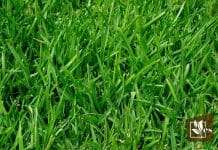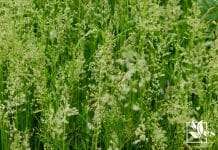You can successfully grow a beautiful lawn by mixing Bermuda Grass with St. Augustine if you live in USDA Zones 7-10.
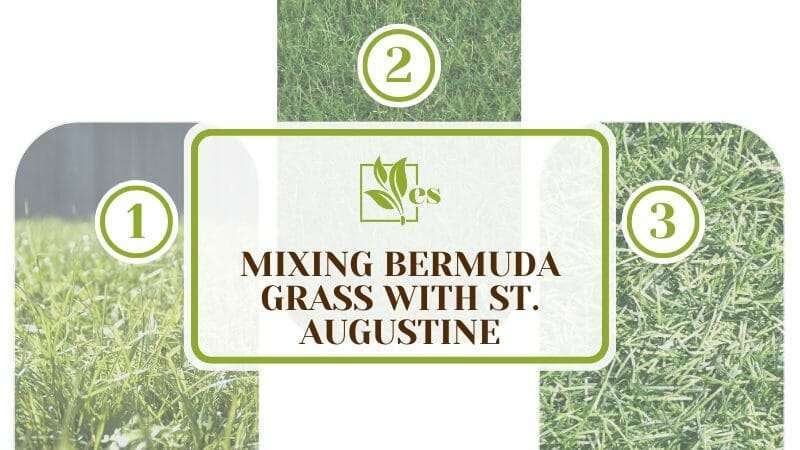
You are looking to establish the best lawn possible for your area and have perhaps heard that mixing these grasses can be a great thing or a bad thing.
We are here to tell you that you can combine the two successfully and show you exactly what to do to succeed — and what to avoid.
JUMP TO TOPIC
- Can you mix Bermuda grass with St. Augustine?
- Will Bermuda grass take over St. Augustine?
- What happens by overseeding St. Augustine with Bermuda grass?
- Can Bermuda and St. Augustine grass co-exist?
- What do I do when Bermuda grass starts taking over St. Augustine?
- How does Bermuda grass behave in a St. Augustine lawn?
Can you mix Bermuda grass with St. Augustine?
Yes! You can mix the two kinds of grass to help make your lawn successful. Of course, you will want to know exactly how to take care of the grass and keep it happy and flourishing, since the grasses have their specific strengths and weaknesses.
St. Augustine Grass is a sod turf. It spreads through above-ground stolons. The stolons spread and root into the soil, helping it spread quickly. So, many describe St. Augustine as aggressive because it can choke out weeds if appropriately maintained.
St. Augustine is the most shade-tolerant grass. St. Augustine grows in the warm-season grass zone. This zone includes southern New Mexico and Arizona, a significant portion of Texas, Louisiana, Mississippi, Alabama, Georgia, South Carolina, and Florida.
Bermuda also forms a turf, but it spreads with rhizomes and stolons. Stolons fill in bare patches of soil, while rhizomes grow underneath the ground. Rhizomes establish root systems. Bermuda is a more aggressive grass than St. Augustine in most climates. Bermuda is used more often for outdoor sports fields.
Bermuda is not shade-tolerant and needs to be mowed very short. Bermuda has a wider range of growth. Bermuda also grows in the transition zone, meaning it can thrive in much more of the United States than St. Augustine grass can.
Will Bermuda grass take over St. Augustine?
It can if the following steps are not taken. Consider the following profiles and comparisons to help you understand the differences and help you keep Bermuda from overtaking St. August.

| Bermuda | St. Augustine |
| Mow to a height of 1”–2” | Mow to a height of 2.5”–4” |
| Irrigation of 1” when the lawn shows drought stress | Irrigation of 2” when the lawn shows drought stress |
| Fertilizer of 1–2 lbs. of nitrogen per growing season for each 1,000 sq ft. | Fertilizer of 2–4 lbs. of nitrogen per growing season for each 1,000 sq ft. |
| Issues: Large patch, dollar spot, spring dead spot | Issues: Chinch bugs, brown patch, gray leaf spot |
St. Augustine will not grow as quickly as Bermuda but can grow such a large mat of grass that it will potentially choke out all weeds in your lawn. Growing blades to a higher level but mowing often will cause the grass to thicken.
There are several ways to manage Bermuda in a St. Augustine law. However, note that spraying the grass is not one of them. Pesticides will harm both types of grasses.
- The easiest way to encourage the growth of St. Augustine is to mow set at a high level — as much as 4” — and cut twice per week.
- Mow with a sharp blade. A sharp blade will help make a cleaner cut. This clean-cut ensures that your grass is healthier.
- The tall blades of grass will shade the Bermuda and help promote St. Augustine growth while slowing Bermuda growth.
- Don’t catch your grass clippings but let them fall back onto the grass and eventually into the soil. The clippings add nitrogen back into the ground and help to shade out the Bermuda grass.
- Don’t use St. Augustine exclusively in high-traffic areas. A lawn that is constantly trampled will allow Bermuda to fill in the bare patches quickly. Bermuda will create a stronghold in well-traveled areas. Then it will continue to spread into the rest of your lawn. It is always better to address potential problems early in the process.
What happens by overseeding St. Augustine with Bermuda grass?
Despite all these potential negative things that Bermuda can do to a lawn when it grows out of control, add Bermuda to your St. Augustine lawn by overseeding it to make it plush and full.
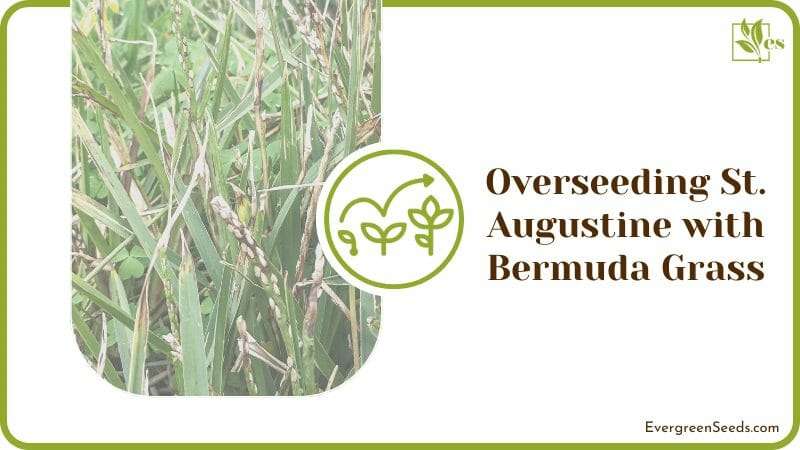
Use Bermuda grass to your advantage in a lawn that is primarily St. Augustine. First, it is expensive to establish St. Augustine because it can only be planted with plugs, sprigs, and sod. But you can plant Bermuda with grass seed and establish a lawn quickly.
Many homeowners seed Bermuda grass, hoping to get a thick lawn. This seeding allows the lawn to take in water without creating mud puddles, protects against erosion, and holds the freshly seeded portion in place. Homeowners also will plant St. Augustine sprigs along with the seed. They may take longer to root and grow, but they will quickly spread and shade out Bermuda once they take hold.
This technique works in the hotter, more humid grass zone. St. Augustine cannot tolerate cooler temperatures, so the farther north you live, Bermuda will more likely take over.
Can Bermuda and St. Augustine grass co-exist?
Yes, Bermuda and St. Augustine will co-exist in the situations we just described. You may be surprised to learn as well that you can’t buy St. Augustine turf without having some Bermuda grass already within it.
In some regards, they partner well together when adequately maintained to give your yard double the protection. There is just a matter of deciding what balance is best for you and is most likely to work well in your region of the country.
For example, you may want to find ways to keep a more Bermuda-based yard primarily, and there are solutions for you as well. In these cases, you would like to keep your lawn shorter, between 1” and 1.5.” Many even use an antique style lawnmower to keep grass cut that short. This type of blade also keeps the lawn healthy.
Mowing more frequently is a must, too, if the St. Augustine grass needs to be kept in balance. Another maintenance tip is to thatch once per year. The best time is often thought to be in spring. Others advise bagging clippings the first mow of the season as an option.
What do I do when Bermuda grass starts taking over St. Augustine?
When Bermuda grass starts taking over St. Augustine, consider the following actions to take and items to be aware of:
- Water your St. Augustine grass more. St. Augustine takes twice as much water as Bermuda grass does to keep it flourishing.
- Fertilize it well too. The St. Augustine grass takes about twice as much nitrogen as does Bermuda.
- Raise the mower. You may be cutting your yard too low. The higher blades of St. Augustine will grow more heartily than the Bermuda grass does in the shade of its blades.
How does Bermuda grass behave in a St. Augustine lawn?
Bermuda mixes well with St. Augustine because it will quickly fill in the patches in the lawn that would take longer to reach with all sod. Bermuda grass seed is less expensive to plant and will spread quickly across your lawn.
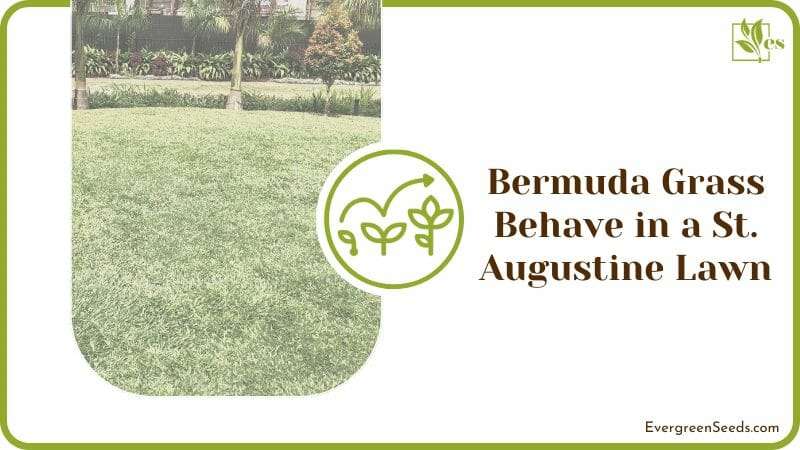
If you live near the beach (or in a hot climate), you will find that St. Augustine does very well. The topsoil can be shallow and have sand, and St. Augustine will still flourish there.
For ongoing maintenance issues, remember that you can’t spray your lawn with weed killers without harming your lawn. Especially when you use diesel or baking soda. It is challenging to spot spray any grasses you believe have gotten out of control. The bare patches of soil left become prime real estate for weeds to germinate, compounding the issue with seeking a perfect lawn.
Pulling grass is almost as damaging to your lawn. Pulling up roots and runners encourage new growth. Many kinds of grass can sprout from roots left in the soil. Each time you pull one plant, multiple more may grow back.
In general, you can manage invading grasses by adjusting your lawn’s maintenance schedule.
This schedule should include the following things as part of your usual maintenance.
- Evaluate the soil’s texture
- Determine pH and nutrient values
- Create a turf-specific irrigation schedule
- Mow at the correct height
- Sharpen your mower’s blade once per season or more often if possible
All grasses have specific maintenance requirements to thrive, and a thriving yard can fight off invading grasses without much intervention on your end.





